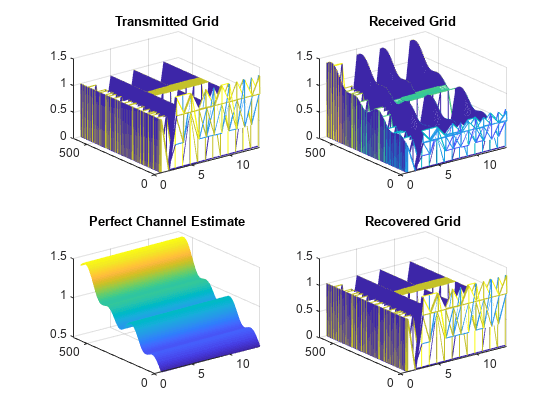lteDLPerfectChannelEstimate
Downlink perfect channel estimation
Syntax
Description
hest = lteDLPerfectChannelEstimate(enb,propchan)lteFadingChannel or lteHSTChannel.
This function provides a perfect MIMO channel estimate after OFDM modulation. Perfect channel estimation is achieved by setting the channel with the desired configuration and sending a set of known symbols through it for each transmit antenna in turn.
hest = lteDLPerfectChannelEstimate(enb,propchan,timefreqoffset)hest to be the precise channel that results when the
receiver is precisely synchronized.
hest = lteDLPerfectChannelEstimate(enb,propchan,timefreqoffset,ntxants)
Note
This syntax is provided to allow modeling of greater than four transmit
antenna planes. For this syntax, the
enb.CellRefP field, is not
required and, if included, is not used to define the number of antenna
planes.
Examples
Input Arguments
Output Arguments
References
[1] 3GPP TS 36.101. “Evolved Universal Terrestrial Radio Access (E-UTRA); User Equipment (UE) Radio Transmission and Reception.” 3rd Generation Partnership Project; Technical Specification Group Radio Access Network. URL: https://www.3gpp.org.
[2] 3GPP TS 36.104. “Evolved Universal Terrestrial Radio Access (E-UTRA); Base Station (BS) Radio Transmission and Reception.” 3rd Generation Partnership Project; Technical Specification Group Radio Access Network. URL: https://www.3gpp.org.
[3] Dent, P., G. E. Bottomley, and T. Croft. “Jakes Fading Model Revisited.” Electronics Letters. Vol. 29, 1993, Number 13, pp. 1162–1163.
[4] Pätzold, Matthias, Cheng-Xiang Wang, and Bjørn Olav Hogstad. “Two New Sum-of-Sinusoids-Based Methods for the Efficient Generation of Multiple Uncorrelated Rayleigh Fading Waveforms.” IEEE Transactions on Wireless Communications. Vol. 8, 2009, Number 6, pp. 3122–3131.
Version History
Introduced in R2013b
